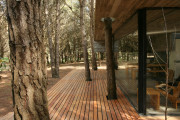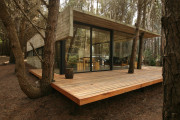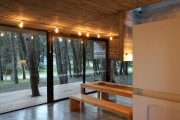Mar Azul House
Location: Mar Azul, Buenos Aires Province,Argentina
Design and Project Management: María Victoria Besonías, Guillermo de Almeida
Collaborators: Diego Grosso
Land area: 470m2
Built area: 75m2
Construction year: 2004
MEMORY
María Victoria Besonías
The place
Mar Azul is a seaside resort on the coast of Buenos Aires, located 12 miles south of Villa Gesell, with an extensive beach of dunes and lush virgin pine trees forest. The owners, members of the studio and for years familiar with this location, chose precisely the splendid scenery of the forest to build a small summer house.
The proposal
The environmental and landscape features of the installation location, the particular use to which it is intended and the lack of a client to condition the project, allowed to undertake this work as an opportunity to experiment with both functional issues as with aesthetic-constructive solutions The search for alternatives would have only three limitations: the work should be of very low impact on the landscape, it would be adjusted to a low budget and its subsequent maintenance should be almost null. With these premises, the house located in an area with 43 pine trees and a gentle slope towards the street, was resolved as a strong prism, free, in minimum height, defined by an exposed concrete enclosure, of texture and color in harmony with the forest, and with large panes of glass to enable full integration with the landscape and, in turn, reflecting it. The complementary functions (auxiliary bath, storage and water tank) were gathered in a vertical wood prism hidden in the trees.
The functional organization
The simple volume that hosts the main functions was solved by proposing two clearly differentiated areas: one exposed, fully glazed, surrounded by a large wooden deck designed to develop the activities of meeting in full integration with the forest, a sort of veranda, and the other protected, with more controlled apertures, destined for bedrooms, bathroom and a cooking place. The house does not have a proper access, since you can enter the house through glazed sliding doors located in two of its facades. This special way of entrance, together with a spatial uncertainty of the living area, allows various ways of use. On the other hand, two metal sliding doors close securely this flexible use place, when required, from the rest of the rooms.
The structural solution
The floor of the house of 6.50mx 10.30m is covered by a concrete slab resting in sight, without intermediate supports, through walls of exposed concrete and iron profiles on the perimeter of it. These metal columns were designed with a minimum section, in order to integrate them and disappear aligned with the openings of anodized aluminum. The tower containing the complementary services is a treated pine wooden structure and with saligna enclosure tables.
The construction
The maritime forest microclimate (shady, scarce wind) and the frequent use of the house in the warm seasons, made viable the constructive solution of low cost and fast execution of an exposed concrete enclosure without supplements to improve the thermal insulation. So the cover is solved without subfloor slope or waterproof membrane. The slab was made with enough slope to allow the free drainage of rainwater to three sides. Furthermore, the expressive quality of concrete and its resistance and impermeability, made superfluous any type of surface finish. It achieves a low cost of execution at finishing and needless future maintenance, since the finishing of the inner and outer concrete was only a manual hand sanding to remove the execution adherences. On the other hand, the color and texture of exposed concrete made with formwork boards is a strong and discreet presence at once, allowing the work to be expressed in harmony with the forest. Internal partitions are of bricks plastered and painted with white latex, the floor is of cement smoothing and the encounter between the two was solved with a recessed aluminum profile, as base. The concrete screed is divided by plates of aluminum in sections of 3.10 m x 3.10m (guide module) and the glazed sector ends together with openings of anodized aluminum with a gutter (also aluminum) to receive water condensation which will occur when the house gets warm in winter because, due to budget reasons, glass with air chamber is not used.
The light treatment
Knowing the surrounding atmosphere generated by the forest (lots of shade and low incidence of orientation), we knew it was essential to ensure a generous amount of light to all the rooms and, in addition to the glass panels of the perimeter, it was important to have an entry of light in the center of the plan. So that it was projected an L shaped cut out, in coincidence with two of the sides of the bath, located in the center of the plan. These deep cuts, which are accompanied by concrete hanging flaps of inverted beams, produce lighting effects that vary during the day, both in the bathroom and in the living area. Regarding the artificial light was sought to emphasize the indeterminacy of the main area of the house with light fixtures that varies the light direction and light intensity. The control of light and visuals from the outside was resolved with black out curtains in the bedrooms and of boile in the glazed area.
The furniture
The furniture specially designed for this house was made from recovered Canadian pine which comes from boxes of package’s engines.
Mar Azul House
Location: Mar Azul, Buenos Aires Province,Argentina
Design and Project Management: María Victoria Besonías, Guillermo de Almeida
Collaborators: Diego Grosso
Land area: 470m2
Built area: 75m2
Construction year: 2004
MEMORY
María Victoria Besonías
The place
Mar Azul is a seaside resort on the coast of Buenos Aires, located 12 miles south of Villa Gesell, with an extensive beach of dunes and lush virgin pine trees forest. The owners, members of the studio and for years familiar with this location, chose precisely the splendid scenery of the forest to build a small summer house.
The proposal
The environmental and landscape features of the installation location, the particular use to which it is intended and the lack of a client to condition the project, allowed to undertake this work as an opportunity to experiment with both functional issues as with aesthetic-constructive solutions The search for alternatives would have only three limitations: the work should be of very low impact on the landscape, it would be adjusted to a low budget and its subsequent maintenance should be almost null. With these premises, the house located in an area with 43 pine trees and a gentle slope towards the street, was resolved as a strong prism, free, in minimum height, defined by an exposed concrete enclosure, of texture and color in harmony with the forest, and with large panes of glass to enable full integration with the landscape and, in turn, reflecting it. The complementary functions (auxiliary bath, storage and water tank) were gathered in a vertical wood prism hidden in the trees.
The functional organization
The simple volume that hosts the main functions was solved by proposing two clearly differentiated areas: one exposed, fully glazed, surrounded by a large wooden deck designed to develop the activities of meeting in full integration with the forest, a sort of veranda, and the other protected, with more controlled apertures, destined for bedrooms, bathroom and a cooking place. The house does not have a proper access, since you can enter the house through glazed sliding doors located in two of its facades. This special way of entrance, together with a spatial uncertainty of the living area, allows various ways of use. On the other hand, two metal sliding doors close securely this flexible use place, when required, from the rest of the rooms.
The structural solution
The floor of the house of 6.50mx 10.30m is covered by a concrete slab resting in sight, without intermediate supports, through walls of exposed concrete and iron profiles on the perimeter of it. These metal columns were designed with a minimum section, in order to integrate them and disappear aligned with the openings of anodized aluminum. The tower containing the complementary services is a treated pine wooden structure and with saligna enclosure tables.
The construction
The maritime forest microclimate (shady, scarce wind) and the frequent use of the house in the warm seasons, made viable the constructive solution of low cost and fast execution of an exposed concrete enclosure without supplements to improve the thermal insulation. So the cover is solved without subfloor slope or waterproof membrane. The slab was made with enough slope to allow the free drainage of rainwater to three sides. Furthermore, the expressive quality of concrete and its resistance and impermeability, made superfluous any type of surface finish. It achieves a low cost of execution at finishing and needless future maintenance, since the finishing of the inner and outer concrete was only a manual hand sanding to remove the execution adherences. On the other hand, the color and texture of exposed concrete made with formwork boards is a strong and discreet presence at once, allowing the work to be expressed in harmony with the forest. Internal partitions are of bricks plastered and painted with white latex, the floor is of cement smoothing and the encounter between the two was solved with a recessed aluminum profile, as base. The concrete screed is divided by plates of aluminum in sections of 3.10 m x 3.10m (guide module) and the glazed sector ends together with openings of anodized aluminum with a gutter (also aluminum) to receive water condensation which will occur when the house gets warm in winter because, due to budget reasons, glass with air chamber is not used.
The light treatment
Knowing the surrounding atmosphere generated by the forest (lots of shade and low incidence of orientation), we knew it was essential to ensure a generous amount of light to all the rooms and, in addition to the glass panels of the perimeter, it was important to have an entry of light in the center of the plan. So that it was projected an L shaped cut out, in coincidence with two of the sides of the bath, located in the center of the plan. These deep cuts, which are accompanied by concrete hanging flaps of inverted beams, produce lighting effects that vary during the day, both in the bathroom and in the living area. Regarding the artificial light was sought to emphasize the indeterminacy of the main area of the house with light fixtures that varies the light direction and light intensity. The control of light and visuals from the outside was resolved with black out curtains in the bedrooms and of boile in the glazed area.
The furniture
The furniture specially designed for this house was made from recovered Canadian pine which comes from boxes of package’s engines.




















